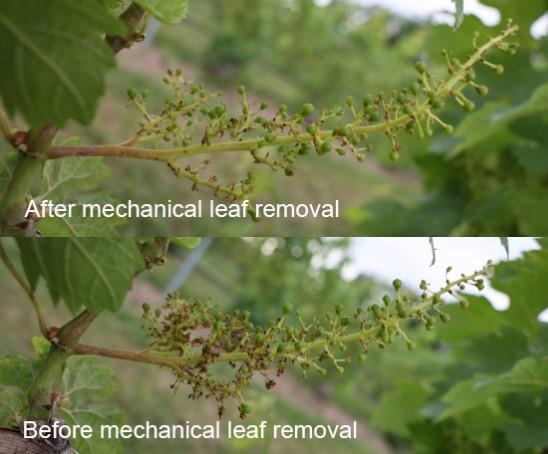There are several methods to implement cluster zone leaf removal in the vineyard, manually or mechanically. Our industry is moving at a very fast pace towards mechanization to improve economic sustainability of grape production in our state and improve canopy management techniques. Summer canopy management is frequently applied, and leaf removal is one of the techniques that can be employed to manage the microclimate in the cluster area. Its effectiveness, however, is closely tied to the phenological stage of grape berry development when the technique is applied.
Although this strategy can have a variety of goals, it is usually employed from fruit set to veraison to improve light exposure and air circulation around the bunches with the benefit of increasing tolerance to mold. The functional relationship between yield and source availability around bloom inherently implies that a new viticulture technique, with leaf removal carried out around flowering or just before, can reduce fruit set and lead to looser clusters. This approach is helpful for excessively tight cluster cultivars like Pinot noir and Riesling in order to reduce berry-to-berry compression and subsequent sensitivity to rot.
Using pre-flowering or pea-size leaf removal strategies offers promise for successful adaptation to global warming predictions for two reasons: 1) it promotes the synthesis of phenolic substances, especially flavonols that can be promoted only early in the season and known to protect the berries from damaging UV radiation; and 2) a beneficial effect in reducing harvest rot complex. Different microclimate conditions, such as temperature and relative humidity, are expected to also alter the microbial count and composition of the cluster and, furthermore, lower the probability of the occurrence of grape rots and the need for spray intervention in the vineyard.
The pea-size leaf removal with a machine works by blowing compressed air into the fruit zone, with enough pressure to shatter leaf tissue and clean clusters from dead flower tissues. Dead ovaries on the peduncle can provide a good environment for Botrytis bunch rot spores to germinate and colonize. The fungus invades the living tissue by using the dead tissue as a food base. The fungus may remain dormant after penetration into the berry until the sugar content of fruits increases and the acid content decreases to a level supporting the development of the fungus. Symptoms will then easily develop in warm humid conditions.
 Photo 2. There are a lot of dead ovaries on the peduncle before mechanical leaf removal. Photo by Esmaeil Nasrollahiazar, MSU Extension
Photo 2. There are a lot of dead ovaries on the peduncle before mechanical leaf removal. Photo by Esmaeil Nasrollahiazar, MSU Extension
Hedging
Hedging's main goal is to remove excess primary and lateral shoot growth from the canopy's top and sides, preventing shading and shoot entanglement between vine rows and allowing worker and tractor traffic through the vineyard. Although hedging reduces canopy by cutting primary and lateral shoots, it does not directly reduce the vine's inherent vigor and, when done in early to midsummer, can further promote growth by inducing lateral shoot growth in vigorous vines.
Hedging is pivotal to maintain light exposure of leaves, fruit and developing buds especially in vigorous canopies with excessive vegetative growth. Hedging can impact on fruit quality, including a reduction of yield and fruit quality when performed too early in the season and for several times before harvest.
Timing of hedging
Hedging is usually performed from fruit set to pre-veraison time when primary and lateral shoots begin to bend (45-degree angle). It's important to keep leaves, fruit and developing buds exposed to enough light in dense canopies with excessive vegetative growth. Hedging too early in the growing season should be avoided because it can cause lateral growth and canopy density to increase. Hedging during veraison may cause delayed fruit maturity as well as a reduction in wood maturity and winter hardiness.
Petiole sampling
Nutrition status of a grapevine is important in producing good yields and high quality in grape production. Analysis of grapevine nutrients status is generally conducted by collecting grapevine petioles at flowering or at the end of veraison. The petioles will provide a good analysis of nutrient levels in the vine, and this analysis is typically done in analytical laboratories. Read more in the Michigan State University Extension article, “Viticultural practices in northwest Michigan at veraison.”
Source : msu.edu